Blog
Blog
It's Time for Beautiful Feet
What Is Athlete’s Foot?
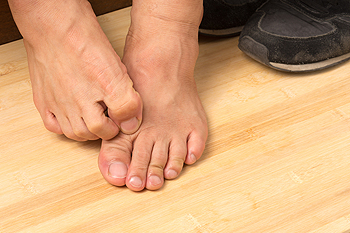 A rash on the foot may be athlete’s foot. It is an uncomfortable foot condition that is caused by a fungus. Common symptoms many patients experience can include severe itchiness on the bottom of the foot and between the toes, a burning sensation, and possible blisters. The type of fungus that causes this ailment lives in warm and moist environments, and is considered to be contagious. Common places the fungi may spread include public swimming pools, shower room floors, and locker rooms. It is advisable to wear appropriate shoes while in these areas, in addition to refraining from sharing towels, shoes, and socks. Mild relief may be attained when an antifungal powder is used, as this may help to alleviate a portion of the itching. If you are afflicted with athlete’s foot, please consult with a podiatrist who can offer you proper treatment solutions.
A rash on the foot may be athlete’s foot. It is an uncomfortable foot condition that is caused by a fungus. Common symptoms many patients experience can include severe itchiness on the bottom of the foot and between the toes, a burning sensation, and possible blisters. The type of fungus that causes this ailment lives in warm and moist environments, and is considered to be contagious. Common places the fungi may spread include public swimming pools, shower room floors, and locker rooms. It is advisable to wear appropriate shoes while in these areas, in addition to refraining from sharing towels, shoes, and socks. Mild relief may be attained when an antifungal powder is used, as this may help to alleviate a portion of the itching. If you are afflicted with athlete’s foot, please consult with a podiatrist who can offer you proper treatment solutions.
Athlete’s Foot
Athlete’s foot is often an uncomfortable condition to experience. Thankfully, podiatrists specialize in treating athlete’s foot and offer the best treatment options. If you have any questions about athlete’s foot, consult with one of our podiatrists from Port Richmond Family Footcare. Our doctors will assess your condition and provide you with quality treatment.
What Is Athlete’s Foot?
Tinea pedis, more commonly known as athlete’s foot, is a non-serious and common fungal infection of the foot. Athlete’s foot is contagious and can be contracted by touching someone who has it or infected surfaces. The most common places contaminated by it are public showers, locker rooms, and swimming pools. Once contracted, it grows on feet that are left inside moist, dark, and warm shoes and socks.
Prevention
The most effective ways to prevent athlete’s foot include:
- Thoroughly washing and drying feet
- Avoid going barefoot in locker rooms and public showers
- Using shower shoes in public showers
- Wearing socks that allow the feet to breathe
- Changing socks and shoes frequently if you sweat a lot
Symptoms
Athlete’s foot initially occurs as a rash between the toes. However, if left undiagnosed, it can spread to the sides and bottom of the feet, toenails, and if touched by hand, the hands themselves. Symptoms include:
- Redness
- Burning
- Itching
- Scaly and peeling skin
Diagnosis and Treatment
Diagnosis is quick and easy. Skin samples will be taken and either viewed under a microscope or sent to a lab for testing. Sometimes, a podiatrist can diagnose it based on simply looking at it. Once confirmed, treatment options include oral and topical antifungal medications.
If you have any questions, please feel free to contact our office located in Lumberton, NJ, . We offer the newest diagnostic and treatment technologies for all your foot care needs.
Toe Lifts to Strengthen the Feet
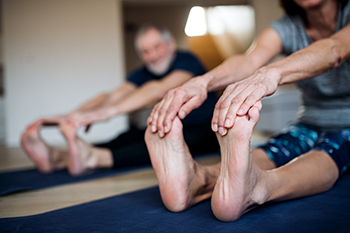 Doing exercises that strengthen your feet is an important part of good foot care, especially if you are an athlete. Weaker feet are more prone to injuries such as plantar fasciitis, bunions, neuromas, and stress fractures. Fortunately, incorporating foot strengthening exercises into your daily routine can be fairly easy. One simple exercise that you can do is the toe lift. To do this, stand with your feet flat on the floor. Slowly raise the big toe of one foot while keeping the other toes on the floor. Then switch, raising your little toes while keeping your big toe on the floor. Repeat on the opposite foot. This exercise helps strengthen the muscles that stabilize your foot and maintain and support your arches. To learn more about foot exercises, please speak with a podiatrist.
Doing exercises that strengthen your feet is an important part of good foot care, especially if you are an athlete. Weaker feet are more prone to injuries such as plantar fasciitis, bunions, neuromas, and stress fractures. Fortunately, incorporating foot strengthening exercises into your daily routine can be fairly easy. One simple exercise that you can do is the toe lift. To do this, stand with your feet flat on the floor. Slowly raise the big toe of one foot while keeping the other toes on the floor. Then switch, raising your little toes while keeping your big toe on the floor. Repeat on the opposite foot. This exercise helps strengthen the muscles that stabilize your foot and maintain and support your arches. To learn more about foot exercises, please speak with a podiatrist.
Exercising your feet regularly with the proper foot wear is a great way to prevent injuries and build strength. If you have any concerns about your feet, contact one of our podiatrists from Port Richmond Family Footcare. Our doctors can provide the care you need to keep you pain-free and on your feet.
Exercise for Your Feet
Exercise for your feet can help you gain strength, mobility and flexibility in your feet. They say that strengthening your feet can be just as rewarding as strengthening another part of the body. Your feet are very important, and we often forget about them in our daily tasks. But it is because of our feet that are we able to get going and do what we need to. For those of us fortunate enough to not have any foot problems, it is an important gesture to take care of them to ensure good health in the long run.
Some foot health exercises can include ankle pumps, tip-toeing, toe rises, lifting off the floor doing reps and sets, and flexing the toes. It is best to speak with Our doctors to determine an appropriate regimen for your needs. Everyone’s needs and bodies are different, and the activities required to maintain strength in the feet vary from individual to individual.
Once you get into a routine of doing regular exercise, you may notice a difference in your feet and how strong they may become.
If you have any questions please feel free to contact our office located in Lumberton, NJ, . We offer the newest diagnostic and treatment technologies for all your foot and ankle needs.
The Most Severe Kind of Ankle Sprain
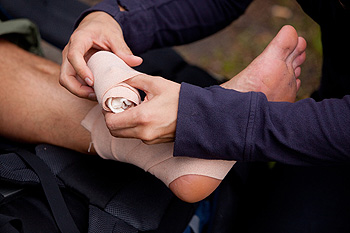 Ankle sprains occur when the foot is twisted beyond its usual range, and the ligaments that connect the bones become torn. Sprains are usually placed into three grades or categories. The first category, known as grade one, is a simple stretching or light tearing of the ligament, and there is minimal pain, swelling, or stiffness. A grade two sprain results from a partial tear of the ligament and leads to moderate swelling and bruising, as well as pain while walking. The most severe type of sprain, a grade three sprain, is a complete tear of the ligaments in the ankle. Swelling and bruising may be severe, and walking can be almost impossible. Grade three sprains may require a cast or brace, and surgery may be considered. Patients who have an ankle sprain should consult with a podiatrist who can make sure that there are no broken bones and provide treatment options.
Ankle sprains occur when the foot is twisted beyond its usual range, and the ligaments that connect the bones become torn. Sprains are usually placed into three grades or categories. The first category, known as grade one, is a simple stretching or light tearing of the ligament, and there is minimal pain, swelling, or stiffness. A grade two sprain results from a partial tear of the ligament and leads to moderate swelling and bruising, as well as pain while walking. The most severe type of sprain, a grade three sprain, is a complete tear of the ligaments in the ankle. Swelling and bruising may be severe, and walking can be almost impossible. Grade three sprains may require a cast or brace, and surgery may be considered. Patients who have an ankle sprain should consult with a podiatrist who can make sure that there are no broken bones and provide treatment options.
Although ankle sprains are common, they aren’t always minor injuries. If you need your ankle injury looked at, contact one of our podiatrists from Port Richmond Family Footcare. Our doctors can provide the care you need to keep you pain-free and on your feet.
How Does an Ankle Sprain Occur?
Ankle sprains are the result of a tear in the ligaments within the ankle. These injuries may happen when you make a rapid shifting movement while your foot is planted. A less common way to sprain your ankle is when your ankle rolls inward while your foot turns outward.
What Are the Symptoms?
- Pain at the sight of the tear
- Bruising/Swelling
- Ankle area is tender to touch
- In severe cases, may hear/feel something tear
- Skin discoloration
Preventing a Sprain
- Wearing appropriate shoes for the occasion
- Stretching before exercises and sports
- Knowing your limits
Treatment of a Sprain
In many cases, the RICE method (Rest, Ice, Compression, and Elevate) is used to treat ankle sprains. However, you should see a podiatrist to see which treatment option would work best with your injury. In severe cases, surgery may be required.
It is important to ask your doctor about rehab options after you receive treatment for your injury. Stretching, strength training, and balance exercises may help the ankle heal while also preventing further injury.
If you have any questions, please feel free to contact our office located in Lumberton, NJ, . We offer the newest diagnostic and treatment technologies for all your foot care needs.
Heel Pain Can Be Treated!
How Is Peripheral Neuropathy Diagnosed?
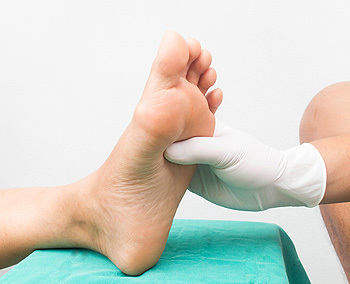 Peripheral neuropathy is a condition in which the nerves of the lower limbs become damaged. This can cause symptoms in the legs and feet such as tingling, numbness, a pins and needles sensation, burning, stabbing, or shooting pains, and weakness. Peripheral neuropathy can be diagnosed through a physical examination of the feet. During the exam, the doctor will look at your feet to check for any injuries or abnormalities. They will also check to see if you have a loss of sensation in your feet by using instruments such as a tuning fork or monofilament. If nerve damage is suspected, the doctor may order further tests, such as an electromyograph (EMG), to confirm the diagnosis and evaluate the extent of damage. If you have the symptoms of peripheral neuropathy in your lower limbs, it is recommended that you seek the care of a podiatrist.
Peripheral neuropathy is a condition in which the nerves of the lower limbs become damaged. This can cause symptoms in the legs and feet such as tingling, numbness, a pins and needles sensation, burning, stabbing, or shooting pains, and weakness. Peripheral neuropathy can be diagnosed through a physical examination of the feet. During the exam, the doctor will look at your feet to check for any injuries or abnormalities. They will also check to see if you have a loss of sensation in your feet by using instruments such as a tuning fork or monofilament. If nerve damage is suspected, the doctor may order further tests, such as an electromyograph (EMG), to confirm the diagnosis and evaluate the extent of damage. If you have the symptoms of peripheral neuropathy in your lower limbs, it is recommended that you seek the care of a podiatrist.
Neuropathy
Neuropathy can be a potentially serious condition, especially if it is left undiagnosed. If you have any concerns that you may be experiencing nerve loss in your feet, consult with one of our podiatrists from Port Richmond Family Footcare. Our doctors will assess your condition and provide you with quality foot and ankle treatment for neuropathy.
What Is Neuropathy?
Neuropathy is a condition that leads to damage to the nerves in the body. Peripheral neuropathy, or neuropathy that affects your peripheral nervous system, usually occurs in the feet. Neuropathy can be triggered by a number of different causes. Such causes include diabetes, infections, cancers, disorders, and toxic substances.
Symptoms of Neuropathy Include:
- Numbness
- Sensation loss
- Prickling and tingling sensations
- Throbbing, freezing, burning pains
- Muscle weakness
Those with diabetes are at serious risk due to being unable to feel an ulcer on their feet. Diabetics usually also suffer from poor blood circulation. This can lead to the wound not healing, infections occurring, and the limb may have to be amputated.
Treatment
To treat neuropathy in the foot, podiatrists will first diagnose the cause of the neuropathy. Figuring out the underlying cause of the neuropathy will allow the podiatrist to prescribe the best treatment, whether it be caused by diabetes, toxic substance exposure, infection, etc. If the nerve has not died, then it’s possible that sensation may be able to return to the foot.
Pain medication may be issued for pain. Electrical nerve stimulation can be used to stimulate nerves. If the neuropathy is caused from pressure on the nerves, then surgery may be necessary.
If you have any questions, please feel free to contact our office located in Lumberton, NJ, . We offer the newest diagnostic and treatment technologies for all your foot care needs.
How Certain Foods May Cause Gout
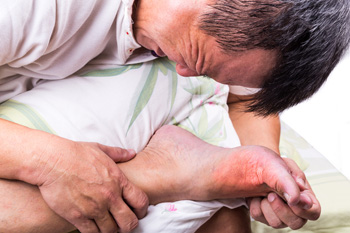 Recent research has shown that eating specific kinds of foods may affect the uric acid levels in the blood. These types of foods can include red meat, shellfish, alcohol, and drinks that are made with large amounts of sugar. Many of these foods have high amounts of purines, which may lead to increasing the levels of uric acid in the body. Gout may be a result of frequently eating these foods and is known to possibly cause debilitating pain and discomfort. It is a condition that affects the joints in the big toe and many patients liken the sensation to crystals in the joints. Mild relief can be felt when plenty of fresh water is frequently consumed and a balanced diet is implemented into your daily regime. If you are afflicted with gout, it is strongly suggested that you are under the care of a podiatrist who can help you to manage this condition.
Recent research has shown that eating specific kinds of foods may affect the uric acid levels in the blood. These types of foods can include red meat, shellfish, alcohol, and drinks that are made with large amounts of sugar. Many of these foods have high amounts of purines, which may lead to increasing the levels of uric acid in the body. Gout may be a result of frequently eating these foods and is known to possibly cause debilitating pain and discomfort. It is a condition that affects the joints in the big toe and many patients liken the sensation to crystals in the joints. Mild relief can be felt when plenty of fresh water is frequently consumed and a balanced diet is implemented into your daily regime. If you are afflicted with gout, it is strongly suggested that you are under the care of a podiatrist who can help you to manage this condition.
Gout is a foot condition that requires certain treatment and care. If you are seeking treatment, contact one of our podiatrists from Port Richmond Family Footcare. Our doctors will treat your foot and ankle needs.
What Is Gout?
Gout is a type of arthritis caused by a buildup of uric acid in the bloodstream. It often develops in the foot, especially the big toe area, although it can manifest in other parts of the body as well. Gout can make walking and standing very painful and is especially common in diabetics and the obese.
People typically get gout because of a poor diet. Genetic predisposition is also a factor. The children of parents who have had gout frequently have a chance of developing it themselves.
Gout can easily be identified by redness and inflammation of the big toe and the surrounding areas of the foot. Other symptoms include extreme fatigue, joint pain, and running high fevers. Sometimes corticosteroid drugs can be prescribed to treat gout, but the best way to combat this disease is to get more exercise and eat a better diet.
If you have any questions please feel free to contact our office located in Lumberton, NJ, . We offer the newest diagnostic and treatment technologies for all your foot and ankle needs.
Education and Podiatry Skills
 The type of doctor that specializes in treating foot and ankle conditions is referred to as a podiatrist. Some of the ailments that podiatrists encounter in their daily practice can include ingrown toenails, plantar fasciitis, heel spurs, and foot deformities. This type of specialist can prescribe custom-made orthotics, and perform physical foot examinations. Additionally, they are able to give advice on how to improve mobility and instruct the patient on rehabilitative practices. Mandatory education includes obtaining a bachelor's degree, followed by earning a Doctor of Podiatric Medicine (D.P.M.) degree, and often followed by a residency program they complete. It is beneficial for successful podiatrists to possess specific skills that can consist of critical thinking, compassion, and dexterity. If you are interested in pursuing a career in this type of medicine, speaking with a podiatrist may be able to help you to determine if this is the correct career choice for you.
The type of doctor that specializes in treating foot and ankle conditions is referred to as a podiatrist. Some of the ailments that podiatrists encounter in their daily practice can include ingrown toenails, plantar fasciitis, heel spurs, and foot deformities. This type of specialist can prescribe custom-made orthotics, and perform physical foot examinations. Additionally, they are able to give advice on how to improve mobility and instruct the patient on rehabilitative practices. Mandatory education includes obtaining a bachelor's degree, followed by earning a Doctor of Podiatric Medicine (D.P.M.) degree, and often followed by a residency program they complete. It is beneficial for successful podiatrists to possess specific skills that can consist of critical thinking, compassion, and dexterity. If you are interested in pursuing a career in this type of medicine, speaking with a podiatrist may be able to help you to determine if this is the correct career choice for you.
If you are experiencing pain in the feet or ankles, don’t join the stubborn majority refusing treatment. Feel free to contact one of our podiatrists from Port Richmond Family Footcare. Our doctors can provide the care you need to keep you pain-free and on your feet.
What Is a Podiatrist?
Someone would seek the care of a podiatrist if they have suffered a foot injury or have common foot ailments such as heal spurs, bunions, arch problems, deformities, ingrown toenails, corns, foot and ankle problems, etc.
Podiatric Treatment
A podiatrist will treat the problematic areas of the feet, ankle or lower leg by prescribing the following:
- Physical therapy
- Drugs
- Orthotic inserts or soles
- Surgery on lower extremity fractures
A common podiatric procedure a podiatrist will use is a scanner or force plate which will allow the podiatrist to know the designs of orthotics. Patients are then told to follow a series of tasks to complete the treatment. The computer will scan the foot a see which areas show weight distribution and pressure points. The podiatrist will read the analysis and then determine which treatment plans are available.
If you have any questions please feel free to contact our office located in Lumberton, NJ, . We offer the newest diagnostic and treatment technologies for all your foot and ankle needs.
Why Has My Toenail Turned Black?
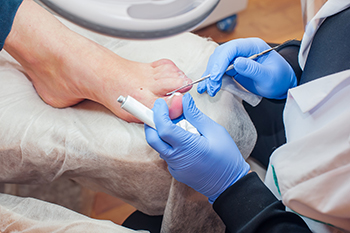 A toenail that has turned black, whether suddenly or gradually, can be an alarming sight. Sometimes, a toenail may turn black following repetitive injuries to the nail. In many cases, the nail can grow out naturally, but in more severe cases when the nail begins to lift off of the nail bed, medical attention will be required. A one-time blunt force injury, like dropping a heavy piece of furniture on your toes, can also turn your toenail black and often causes pain and swelling. Fungal nail infections typically cause toenails to turn white or yellow, but as debris builds up near the infection, the toenail can also turn black. Natural changes in pigmentation that can occur with age may turn the nails darker in people with darker skin. Other potential causes of black toenails include melanoma, and underlying medical conditions such as diabetes, kidney disease, heart disease, and anemia. If you notice a change in the color of your toenails, it is suggested that you seek the care of a podiatrist.
A toenail that has turned black, whether suddenly or gradually, can be an alarming sight. Sometimes, a toenail may turn black following repetitive injuries to the nail. In many cases, the nail can grow out naturally, but in more severe cases when the nail begins to lift off of the nail bed, medical attention will be required. A one-time blunt force injury, like dropping a heavy piece of furniture on your toes, can also turn your toenail black and often causes pain and swelling. Fungal nail infections typically cause toenails to turn white or yellow, but as debris builds up near the infection, the toenail can also turn black. Natural changes in pigmentation that can occur with age may turn the nails darker in people with darker skin. Other potential causes of black toenails include melanoma, and underlying medical conditions such as diabetes, kidney disease, heart disease, and anemia. If you notice a change in the color of your toenails, it is suggested that you seek the care of a podiatrist.
For more information about treatment, contact one of our podiatrists of Port Richmond Family Footcare. Our doctors can provide the care you need to keep you pain-free and on your feet.
Toenail Fungus Treatment
Toenail fungus is a condition that affects many people and can be especially hard to get rid of. Fortunately, there are several methods to go about treating and avoiding it.
Antifungals & Deterrence
Oral antifungal medicine has been shown to be effective in many cases. It is important to consult with a podiatrist to determine the proper regiment for you, or potentially explore other options.
Applying foot powder on the feet and shoes helps keep the feet free of moisture and sweat.
Sandals or open toed shoes – Wearing these will allow air movement and help keep feet dry. They also expose your feet to light, which fungus cannot tolerate. Socks with moisture wicking material also help as well.
If you have any questions please feel free to contact our office located in Lumberton, NJ, . We offer the newest diagnostic tools and technology to treat your foot and ankle needs.
Can Stretches Help Cuboid Syndrome?
 The outer side of the foot is generally where pain from cuboid syndrome is felt. It develops as a result of a displaced cuboid bone, and can happen for several reasons. These can include having weak tendons in the feet, wearing shoes that do not have adequate room for the toes to move freely in, or conditions such as flat feet or high arches. This bone is located between the pinky toe and the heel, and repetitive force may shift the bone out of alignment. Common symptoms many patients feel can consist of swelling on the outside of the foot, pain while standing or walking, and pain and discomfort may extend to the sole of the foot. There are stretches that can be practiced that may help to alleviate the pain. It is suggested that you consult with a podiatrist who can help you to manage cuboid syndrome.
The outer side of the foot is generally where pain from cuboid syndrome is felt. It develops as a result of a displaced cuboid bone, and can happen for several reasons. These can include having weak tendons in the feet, wearing shoes that do not have adequate room for the toes to move freely in, or conditions such as flat feet or high arches. This bone is located between the pinky toe and the heel, and repetitive force may shift the bone out of alignment. Common symptoms many patients feel can consist of swelling on the outside of the foot, pain while standing or walking, and pain and discomfort may extend to the sole of the foot. There are stretches that can be practiced that may help to alleviate the pain. It is suggested that you consult with a podiatrist who can help you to manage cuboid syndrome.
Cuboid syndrome, also known as cuboid subluxation, occurs when the joints and ligaments near the cuboid bone in the foot become torn. If you have cuboid syndrome, consult with one of our podiatrists from Port Richmond Family Footcare. Our doctors will assess your condition and provide you with quality foot and ankle treatment.
Cuboid syndrome is a common cause of lateral foot pain, which is pain on the outside of the foot. The condition may happen suddenly due to an ankle sprain, or it may develop slowly overtime from repetitive tension through the bone and surrounding structures.
Causes
The most common causes of cuboid syndrome include:
- Injury – The most common cause of this ailment is an ankle sprain.
- Repetitive Strain – Tension placed through the peroneus longus muscle from repetitive activities such as jumping and running may cause excessive traction on the bone causing it to sublux.
- Altered Foot Biomechanics – Most people suffering from cuboid subluxation have flat feet.
Symptoms
A common symptom of cuboid syndrome is pain along the outside of the foot which can be felt in the ankle and toes. This pain may create walking difficulties and may cause those with the condition to walk with a limp.
Diagnosis
Diagnosis of cuboid syndrome is often difficult, and it is often misdiagnosed. X-rays, MRIs and CT scans often fail to properly show the cuboid subluxation. Although there isn’t a specific test used to diagnose cuboid syndrome, your podiatrist will usually check if pain is felt while pressing firmly on the cuboid bone of your foot.
Treatment
Just as the range of causes varies widely, so do treatments. Some more common treatments are ice therapy, rest, exercise, taping, and orthotics.
If you have any questions, please feel free to contact our office located in Lumberton, NJ, . We offer the newest diagnostic and treatment technologies for all your foot care needs.






